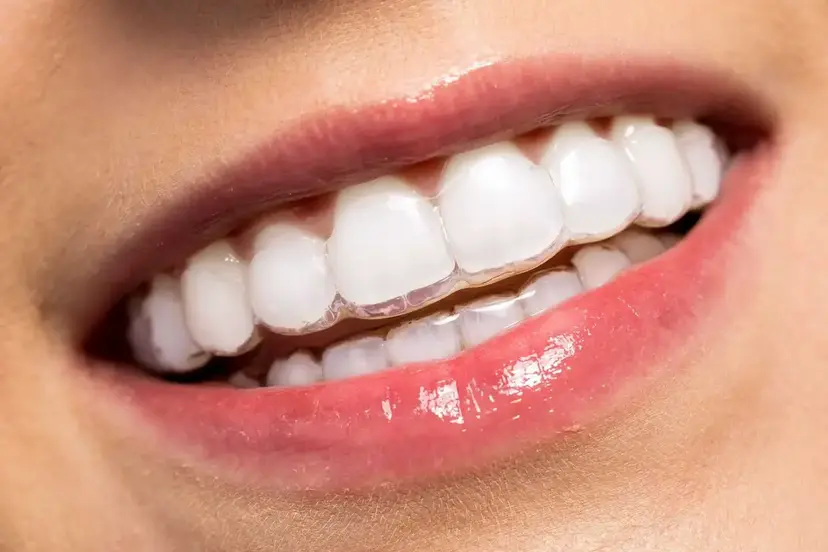MakeO blog
Two of the most revolutionary dental treatments for misaligned teeth are ceramic braces and clear aligners. Known for their concealed way of treating teeth gaps and bite problems, these two options are widely favoured by those looking for more inconspicuous ways of getting a smile makeOver. But what are these braces alternatives and how do they differ from each other?
Read along to find out the major differences between ceramic braces and clear aligners so that you can choose one that best suits your orthodontic issue.
Ceramic Braces vs Invisible Braces
Clueless about ceramic braces or clear aligners? You must keep in mind that ceramic braces are also commonly referred to as clear or invisible braces. These braces are picking up steam today and many people are opting for these over metal braces.
Wondering why? This is because ceramic or clear braces allow you to discreetly correct your smile, unlike traditional metal braces. Moreover, they are as durable as traditional braces and cost-effective in the long run. However, note that they can stain easily and are hard to maintain.
What are Ceramic Braces?
Ceramic braces are a type of invisible braces that have the same brackets fixed to the teeth with wires. The main difference between traditional braces and ceramic braces is that ceramic braces are made from an enamel-coloured ceramic material which makes them almost invisible. Much like traditional braces, ceramic braces also require tightening every 4-6 weeks to move your teeth and correct your smile.
What are Clear Aligners?
Clear aligners such as makeO toothsi aligners are clear plastic trays made from 3D scans of your teeth. These require no brackets or wires and apply gentle pressure on your teeth to correct your smile. makeO toothsi aligners are invisible, almost painless, and removable, so you can take them off while eating, brushing or flossing easily.
Difference Between Clear Aligners and Ceramic Braces
Wondering about the differences between ceramic braces vs aligners? Here is a table which explains a few important ones to remember:
Ceramic braces
Stain resistance
- Ceramic braces have tooth-coloured brackets that stain easily.
Pain
- Ceramic braces consist of brackets and wires. Hence, you might find them painful and uncomfortable until you get adjusted to them.
Removable
- Typically, ceramic braces are not removable.
Maintenance
- Ceramic braces make it difficult for you to brush and floss your teeth. Hence, they are tough to maintain.
Dental visits
- Ceramic braces require you to visit your dentist at least 8-12 times for follow-up visits.
Treatment time
Ceramic braces require more time than even traditional braces as they cannot apply as much force as metal. Typically, they take anywhere between 18-36 months to correct your smile.
Clear Aligners
Stain resistance
- Clear aligners are made using high-quality stain-resistant material. They don’t stain easily and you don’t need to go on a strict diet to ensure that they don’t turn pale.
Pain
- On the other hand, clear aligners are made from plastic trays. They are hence minimally painful and are easy to wear.
Removable
- Clear aligners are removable. This means you can remove them before you go to bed.
Maintenance
- Clear aligners allow easy brushing and flossing. Hence, they are easy to maintain.
Dental visits
- makeO toothsi aligners give you the luxury of getting clear aligners from the comfort of your abode. So, you can completely skip in-person dental clinic visits.
Treatment time
- makeO toothsi aligners take about 12- 18 months to give you the smile of your dreams.
The Verdict
While ceramic braces are a more inconspicuous version of traditional braces, they require the same number of dental clinic visits, and give similar discomfort and pain as they have the same components: brackets and wires. makeO toothsi aligners do not contain any of these components and are simple clear plastic trays made to fit your teeth and apply gentle force on them.
makeO toothsi aligners are a convenient and pain-free solution. You can book a 3D scan right from your home and start your treatment. Backed by 100+ orthodontists and dentists, be sure to check out makeO toothsi reviews if you need further convincing. Made from resilient and flexible aligner material, makeO toothsi aligners reviews are sure to impress you!
FAQs:
Do invisible aligners work better than braces?
Invisible aligners are perfect for late teens and adults who are looking for a convenient and invisible way of correcting their smile. Note that clear aligners work well on several misalignment types such as teeth gap, crossbite, crooked teeth, open bite and more.
Which is better: braces or aligners?
Clear aligners are not only comfortable to wear but are also removable and easy to maintain, while braces are fixed, and require food restrictions and frequent visits to the dentist. And, unlike braces, clear aligners are invisible to the naked eye so you can flaunt your smile without any brackets or wires.
Which is more painful: aligners or braces?
Aligners like makeO toothsi clear aligners are almost painless as they use gentle pressure to correct your smile. Braces on the other hand, consist of wires and brackets that cause discomfort and pain.
What are the disadvantages of aligners?
While aligners are removable, clear and almost painless, they do require maintenance. They need to be rinsed and cleaned with an aligner cleaning solution. They cannot be worn during eating and they must be stored in an aligner case so as to avoid deformities and stains. Heat also affects aligners hence they must be kept away from hot places at all times!
What happens if I stop wearing my aligners?
Aligners need to be worn for at least 22 hours a day. If you stop wearing your aligners, you will notice your teeth moving back to their original position.
Related articles

This Diwali, Smile Bright With makeO Teeth Whitening Kit

Types of Braces: Removable vs Fixed Braces, Which is Right For You?

Dr. Pravin Shetty: Pioneer in Lingual Orthodontics & Innovative Smile Solutions
How do I Know I’m the Right Candidate for makeO toothsi Teeth Aligners?

